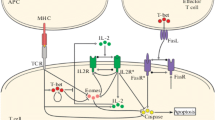Abstract
The immune system represents the natural defense of an organism. It comprises a network of cells, molecules, and organs whose primary tasks are to defend the organism from pathogens, and to maintain its integrity. Since our knowledge of the immune system is still incomplete, formal modeling can help provide a better understanding of its underlying principles and organization. In this chapter we provide a brief introduction to the biology of the immune system, recalling several approaches used in the modeling of the immune system, and then describe a model based on P systems. Starting from a variant of P systems called client-server P systems, we use an abstract simulator as a useful intermediate step from a formal theory suitable for theoretical results to a software implementation of a molecular network. Finally, our approach leads to novel software able to provide new insights into the interactions influencing T cell behavior with the use of statistical correlations of the software experiments’ results.
Access this chapter
Tax calculation will be finalised at checkout
Purchases are for personal use only
Preview
Unable to display preview. Download preview PDF.
Similar content being viewed by others
References
N. Bellomo, M. Lo Schiavo: Lecture Notes on the Generalized Boltzmann Equation. World Scientific, Singapore, 2000.
E. Benjamini, R. Coico, G. Sunshine: Immunology: A Short Course. Wiley, 2000.
F. Burnet: The Clonal Selection Theory of Acquired Immunity. Vanderbilt University, Nashville, 1959.
C. Chan: Modeling T Cell Activation. PhD thesis, Center for Nonlinear Dynamics and its Applications, University College London, 2002.
G. Ciobanu, B. Tanasă, D. Dumitriu, D. Huzum, G. Moruz: Simulation and Prediction of T Cell Responses. Proc. 3rd Conf. on Systems Biology ICSB’02, Stockholm, 2002, 88–89.
G. Ciobanu, D. Dumitriu, D. Huzum, G. Moruz, B. Tanasă: Client-Server P Systems in Modeling Molecular Interaction. In Membrane Computing, WMC-CdeA 2002, Curtea de Argeş, Romania, Revised Papers (Gh. Păun, G. Rozenberg, A. Salomaa, C. Zandron, eds.), LNCS 2597, Springer, 2003, 203–218.
G. Ciobanu, D. Huzum: Discrete Event Systems and Client-Server Model for Signaling Mechanisms. In Computational Methods in Systems Biology (C. Priami, ed.), LNCS 2602, Springer, Berlin, 2003, 175–177.
D. Dasgupta, ed.: Artificial Immune Systems and Their Applications. Springer, 1999.
S. Forrest, S.A. Hofmeyr: Immunology as Information Processing. In Design Principles for the Immune System and Other Distributed Autonomous Systems (L.A. Segel, I. Cohen, eds.), Oxford University Press, 2001.
M.A. Gibson: Computational Methods for Stochastic Biological Systems. PhD thesis, California Institute of Technology, 2000.
D.T. Gillespie: Exact Simulation of Coupled Chemical Reactions. J. Physical Chemistry, 1977.
D.T. Gillespie: A General Method for Numerically Simulating the Stochastic Time Evolution of Coupled Chemical Reactions. J. Computational Physics, 1977.
Z. Grossman, A. Singer: Tuning of Activation Thresholds Explains Flexibility in the Selection and Development of T Cells in the Thymus. PNAS, 93 (1996), 14747–14752.
N.K. Jerne: The Immune System. Sci. Am., 229,1 (1973), 52–60.
N.K. Jerne: Towards a Network Theory of the Immune System. Ann. Immunol. (Inst. Pasteur), 125C (1974), 373–389.
M. Kaufman, J. Urbain, R. Thomas: Towards a Logical Analysis of the Immune Response. J. Theor. Biol. 114 (1985), 527.
S. Motta, V. Brusic: Mathematical Modeling of the Immune System. In Modelling in Molecular Biology (G. Ciobanu, G. Rozenberg, eds.), Springer, Berlin, 2004, 193–218.
P. Myung, N. Boerthe, G. Koretzky: Adapter Proteins in Lymphocyte Antigen-Receptor Signaling. Current Opinion in Immunology, 12 (2000), 256–266.
Gh. Păun: Computing with Membranes. Journal of Computer and System Sciences, 61 (2000), 108–143.
Gh. Păun: Membrane Computing. An Introduction. Springer, Berlin, 2002.
A.S. Perelson, Ed.: Theoretical Immunology. SFI Studies in the Sciences of Complexity, Addison-Wesley, Boston, 1988.
A.S. Perelson, G. Weisbuch: Immunology for Physicists. Rev. Mod. Phys., 69 (1997), 1219–1267.
N. Rao, I. Dodge, H. Band: The Cbl Family of Ubiquitin Ligases: Critical Negative Regulators of Tyrosine Kinase Signaling in the Immune System. Journal of Leukocyte Biology, 71 (2002), 753–763.
I. Roitt, J. Brostoff, D. Male: Immunology, 6th edn. Harcourt, 2001.
C. Rudd, H. Schneider: Cbl Sets the Threshold for Autoimmunity. Current Biology, 10 (2000), 344–347.
G. Weisbuch, H. Atlan: Control of the Immune Response. J. Phys. A, 21 (1988), 189–192.
R.M. Zorzenon Dos Santos: Immune Responses: Getting Close to Experimental Results with Cellular Automata Models. In Annual Reviews of Computational Physics (D. Stauffer, ed.), Vol. V, World Scientific, Singapore, 1999, 159–202.
Author information
Authors and Affiliations
Editor information
Editors and Affiliations
Rights and permissions
Copyright information
© 2006 Springer-Verlag Berlin Heidelberg
About this chapter
Cite this chapter
Ciobanu, G. (2006). Modeling Cell-Mediated Immunity by Means of P Systems. In: Ciobanu, G., Păun, G., Pérez-Jiménez, M.J. (eds) Applications of Membrane Computing. Natural Computing Series. Springer, Berlin, Heidelberg. https://doi.org/10.1007/3-540-29937-8_5
Download citation
DOI: https://doi.org/10.1007/3-540-29937-8_5
Publisher Name: Springer, Berlin, Heidelberg
Print ISBN: 978-3-540-25017-3
Online ISBN: 978-3-540-29937-0
eBook Packages: Computer ScienceComputer Science (R0)




